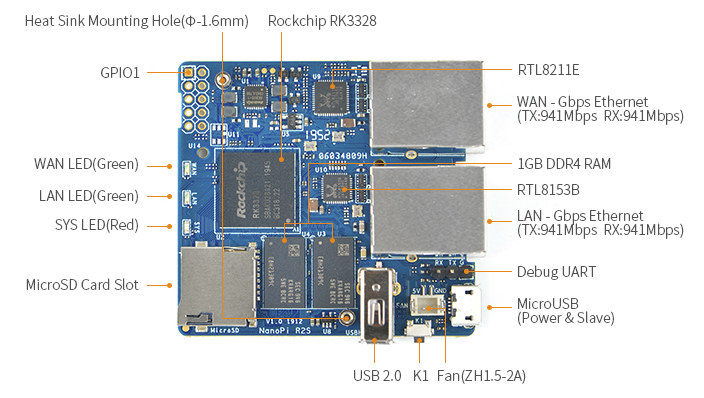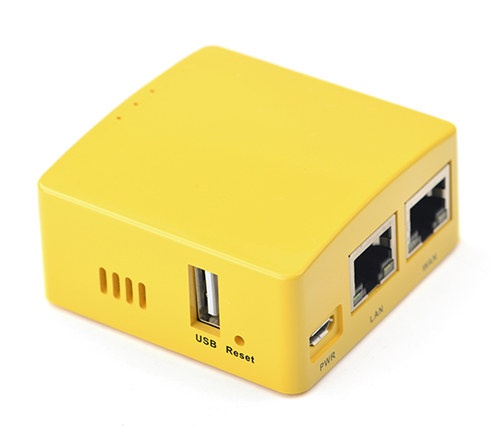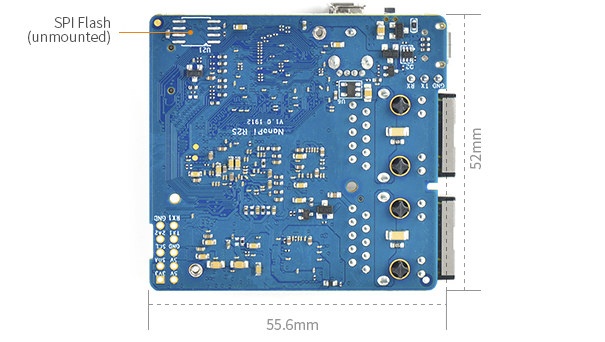FriendlyElec launched NanoPi R1S router with two Ethernet ports based on either Allwinner H3 or H5 processor coupled with 512MB RAM last November. Both ports are “Gigabit” Ethernet port, but one is implemented via a USB 2.0 to Ethernet controller with a maximum bandwidth of around 330 Mbps.
If you’d like to get two Gigabit Ethernet reaching close to 1 Gbps each, and your target application would benefit from a bit more memory, the company is now working on NanoPi R2S based on Rockchip RK3328 processor with 1GB DDR4 memory, one Ethernet port using the GMAC from the chip, and one Ethernet port relying one a USB 3.0 to Ethernet controller.
- SoC – Rockchip RK3328 quad-core Cortex-A53 @ 1.5 GHz with Arm Mali-450MP2
- System Memory – 1GB DDR4 RAM
- Storage – MicroSD Slot, SPI flash footprint
- Connectivity
- 1x Gigabit Ethernet (WAN) up to 941 Mbps (measured)
- 1x Gigabit Ethernet (LAN) up to 941 Mbps (measured) via Realtek RTL8153 USB 3.0 to Ethernet controller
802.11b/g/n WiFi 4 with IPX-I antenna connector
- USB – 1x USB Type-A host port, 1x micro USB port (power + slave)
- Debugging – 3-pin 2.54mm pitch header for serial console
- Expansion – 10-pin GPIO header with GPIOs, I2C, UART, IR_Rx, 5V, 3.3V and GND
- Misc – 3x LEDs (WAN, LAN, SYS), K1 reset button, fan header
- Power Supply – 5VDC/3A via micro USB port
- Dimensions – 55.6 x 52mm
- Temperature Range – -20 to 70
Another addition is the presence of a 10-pin I/O which was completely lacking from NanoPi R1S router board. Since WiFi is missing, the company recommends USB dongles based on RTL8821CU since those are supported by the default firmware out of the box. The board also supports 4G LTE via Huawei 8372H-155 USB dongle.
The company will provide both FriendlyWrt, based on OpenWrt, and FriendlyCore, based on Ubuntu 18.04 Core, for the board. More details can be found in the Wiki (Chinese version only for now).

That also means pricing is not available, but considering NanoPi R1S sells for $19.99 (H3) / $22.99 (H5) with the enclosure, I’d expect NanoPi R2S to sell for a few dollars more, maybe $26.99?, due to the extra memory and USB 3.0 to Ethernet controller.

Jean-Luc started CNX Software in 2010 as a part-time endeavor, before quitting his job as a software engineering manager, and starting to write daily news, and reviews full time later in 2011.
Support CNX Software! Donate via cryptocurrencies, become a Patron on Patreon, or purchase goods on Amazon or Aliexpress





